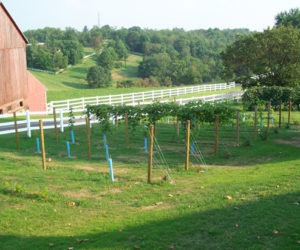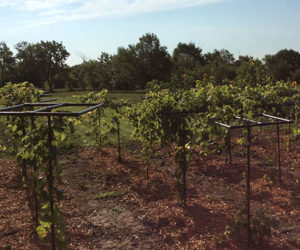So you nurtured your vines from spring through fall and finally harvested your grapes. It’s time to take off the viticulture hat and put on the winemaking hat, right? Wait! Your work in the vineyard isn’t quite over yet. You still need to clean up your home vineyard and put it to bed correctly for the winter.
After the fruit has been picked and crushed, there are a few more details that need to be considered in the vineyard:
Make sure all fruit, even ugly fruit and bird-pecked clusters/stems, have been totally removed from the vines and, preferably, removed from the property. Fruit/stems that are allowed to stay on or near the vineyard will increase rot and mildew pressure the following year. Bare stems are not as big of a mildew/Botrytis threat, but can still hold spores over winter. If you are pressed for time, you can just cut all the missed/damaged clusters/stems on the ground, where they will be less of an issue.
Make sure to do a vineyard walkthrough after your day of winemaking to determine all fruit has been harvested, a row has not been missed, equipment has been gathered, buckets/picking shears collected, and pickers aren’t passed out between rows. I have found half rows and single rows of unpicked fruit after night harvest that made a $15,000 barrel of wine. Don’t leave any clusters behind! That’s wine that could be in your glass!
Give the vines a deep irrigation if rainfall hasn’t already saturated the ground. After being freed from their burden of fruit, the vines go into a stage of root growth (called a root flush), vines continue to activate next year’s fruit buds, and they turn their stores of nitrogen and carbohydrates into a form that can be saved for the following growing season. For these processes to succeed, the vines need to keep some leaves for photosynthesis, but you do not want to induce active vine growth with fertilization. I consider a 10 gallon (38 L)/vine irrigation ample in clay soils, but in sandy soils you can double that if water is available. If the fall rains have already started or the soil is already charged with water, there is no need for supplemental irrigation.
Consider growing a cover crop for fertilization and erosion control. Find out what farmers in your area use as a cover crop, spread seeds between your vine rows and then rake them into the soil so the birds and squirrels don’t get them all. I really like barley and rye for erosion and if your vineyard needs some extra vigor/nutrients next year, plant legumes, clovers, and vetch!
If you live in an area with intense winter cold, make sure to check with your local university on ways to winterize your vineyard to keep it from suffering permanent cold damage! One example of something you may want to do is build a mound of soil up around the base of each grapevine with a few inches of soil around the graft union. This provides freeze protection for the most fragile parts of the grafted grapevine.
Harvest is a magical time in the vineyard. Take time from your hard labor to enjoy the sights, smells and tastes of crush. After the fruit is crushed and the vineyard is irrigated, don’t forget the post-harvest irrigation/feeding of your crew: Reward them with a plate stacked with cheeses (and maybe some tidbits of BBQ ostrich) and glasses filled with wine.







